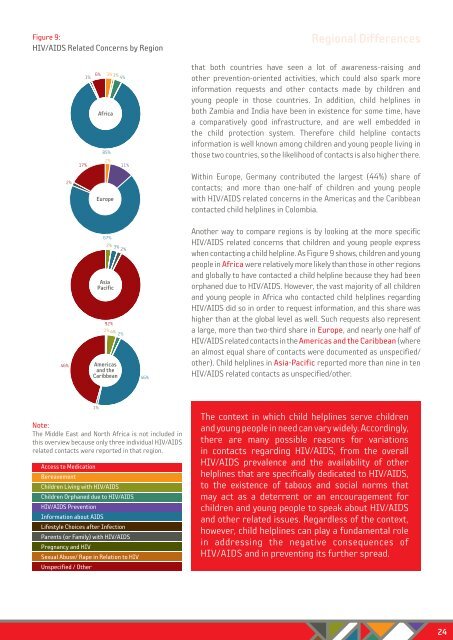The Voices of Children and Young People
FjLR300hYsM
FjLR300hYsM
Create successful ePaper yourself
Turn your PDF publications into a flip-book with our unique Google optimized e-Paper software.
Figure 9:<br />
HIV/AIDS Related Concerns by Region<br />
Regional Differences<br />
2%<br />
3%<br />
1% 6% 1% 4%<br />
Africa<br />
85%<br />
2%<br />
17%<br />
11%<br />
Europe<br />
that both countries have seen a lot <strong>of</strong> awareness-raising <strong>and</strong><br />
other prevention-oriented activities, which could also spark more<br />
information requests <strong>and</strong> other contacts made by children <strong>and</strong><br />
young people in those countries. In addition, child helplines in<br />
both Zambia <strong>and</strong> India have been in existence for some time, have<br />
a comparatively good infrastructure, <strong>and</strong> are well embedded in<br />
the child protection system. <strong>The</strong>refore child helpline contacts<br />
information is well known among children <strong>and</strong> young people living in<br />
those two countries, so the likelihood <strong>of</strong> contacts is also higher there.<br />
Within Europe, Germany contributed the largest (44%) share <strong>of</strong><br />
contacts; <strong>and</strong> more than one-half <strong>of</strong> children <strong>and</strong> young people<br />
with HIV/AIDS related concerns in the Americas <strong>and</strong> the Caribbean<br />
contacted child helplines in Colombia.<br />
67%<br />
2% 3% 2%<br />
Asia<br />
Pacific<br />
46% Americas<br />
<strong>and</strong> the<br />
Caribbean<br />
92%<br />
1% 4% 2%<br />
46%<br />
Another way to compare regions is by looking at the more specific<br />
HIV/AIDS related concerns that children <strong>and</strong> young people express<br />
when contacting a child helpline. As Figure 9 shows, children <strong>and</strong> young<br />
people in Africa were relatively more likely than those in other regions<br />
<strong>and</strong> globally to have contacted a child helpline because they had been<br />
orphaned due to HIV/AIDS. However, the vast majority <strong>of</strong> all children<br />
<strong>and</strong> young people in Africa who contacted child helplines regarding<br />
HIV/AIDS did so in order to request information, <strong>and</strong> this share was<br />
higher than at the global level as well. Such requests also represent<br />
a large, more than two-third share in Europe, <strong>and</strong> nearly one-half <strong>of</strong><br />
HIV/AIDS related contacts in the Americas <strong>and</strong> the Caribbean (where<br />
an almost equal share <strong>of</strong> contacts were documented as unspecified/<br />
other). Child helplines in Asia-Pacific reported more than nine in ten<br />
HIV/AIDS related contacts as unspecified/other.<br />
1%<br />
Note:<br />
<strong>The</strong> Middle East <strong>and</strong> North Africa is not included in<br />
this overview because only three individual HIV/AIDS<br />
related contacts were reported in that region.<br />
Access to Medication<br />
Bereavement<br />
<strong>Children</strong> Living with HIV/AIDS<br />
<strong>Children</strong> Orphaned due to HIV/AIDS<br />
HIV/AIDS Prevention<br />
Information about AIDS<br />
Lifestyle Choices after Infection<br />
Parents (or Family) with HIV/AIDS<br />
Pregnancy <strong>and</strong> HIV<br />
Sexual Abuse/ Rape in Relation to HIV<br />
Unspecified / Other<br />
<strong>The</strong> context in which child helplines serve children<br />
<strong>and</strong> young people in need can vary widely. Accordingly,<br />
there are many possible reasons for variations<br />
in contacts regarding HIV/AIDS, from the overall<br />
HIV/AIDS prevalence <strong>and</strong> the availability <strong>of</strong> other<br />
helplines that are specifically dedicated to HIV/AIDS,<br />
to the existence <strong>of</strong> taboos <strong>and</strong> social norms that<br />
may act as a deterrent or an encouragement for<br />
children <strong>and</strong> young people to speak about HIV/AIDS<br />
<strong>and</strong> other related issues. Regardless <strong>of</strong> the context,<br />
however, child helplines can play a fundamental role<br />
in addressing the negative consequences <strong>of</strong><br />
HIV/AIDS <strong>and</strong> in preventing its further spread.<br />
24


